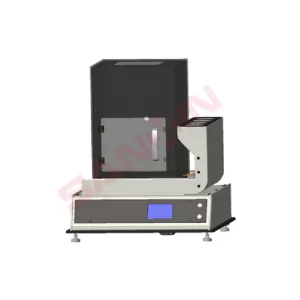Textile Thermal Resistance Tester

Application Scope:
It is used for the thermal resistance testing of various textile products, textile fabrics for manufacturing textiles, film coatings, foams, leathers, and composite materials. It can also be applied to test the thermal insulation performance of different fabrics, quilted products, and other thermal insulation materials.
Applicable Standards: GB/T35762 – 2017, ASTM D1518, etc.
Technical Specifications:
- Thermal resistance test range: 0 – 2000×10⁻³ (m²·K/W)
- Repeatability: ±3.5%;
- Resolution: 0.1×10⁻³ (m²·K/W);
- Test temperature adjustment range: 20 – 50 °C;
- Air velocity above the specimen surface: 1 m/s;
- The lifting range of the specimen platform: 0 – 45 mm;
- Test time setting range: 0 – 9999 s;
- Temperature control accuracy: ±0.3 °C;
- Temperature indication resolution: 0.1 °C;
- Pre – heating cycle: 1 – 99;
- Specimen size: 350×350 mm;
- Test plate size: 200×200 mm;
- Overall dimensions: 550×600×750 mm (L×W×H);
- Power supply: AC220V ± 10%, 200W, 50Hz.
Instrument Features:
- The use of high – precision temperature sensors significantly improves the testing accuracy and stability of the instrument.
- With microcomputer control and a data processor, it can directly measure and calculate various properties of the specimen (thermal resistance, thermal retention rate, heat transfer coefficient, clo value). No manual calculation is needed, and the testing speed is fast.
- It features a high – definition touch – screen display, which can display, store all the data during the testing process and the final statistical results, and also provides a query function.
- A computer and printer can be optionally equipped, and the test data can be directly output by the printer.
- It has powerful testing functions. By replacing the micro – climate hood, the testing methods can be automatically switched. The testing methods include: GB/T11048 – 2008, Thermal resistance of Method A, Thermal resistance of Method B, GB/T35762 – 2017, GB/T10048 – 1989.

